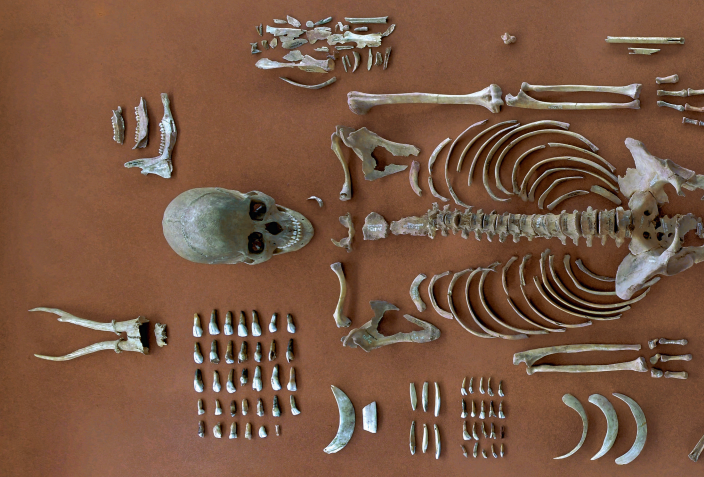Genetic research has unlocked the mystery behind a Mesolithic double burial unearthed in Germany. Dating back to 7000-6800 BCE, the discovery of an adult woman and an infant in Bad Dürrenberg has long perplexed archaeologists.
Now, recent genetic analysis has unraveled compelling details about their relationship, shedding new light on their identities and the cultural significance of their burial, this report from Phys.org tells us.

Genetic Research Sheds Light to Mysterious Shaman Burial in Germany
The burial site, uncovered in 1934 during construction in the spa gardens of Bad Dürrenberg, has been regarded as an exceptional find within Central European Mesolithic archaeology.
The woman's burial was particularly striking due to her seated position and the array of unusual artifacts interred alongside her.
Excavations conducted for the upcoming State Garden Exhibition in 2024 uncovered new artifacts and a significant amount of human remains associated with the burial.
Flint tools, bone and antler artifacts, red ochre, and a collection of animal remains, including terrapin shells and partly pierced teeth, suggested a significant ceremonial or shamanic connection.
Researchers, including Jörg Orschiedt from the State Office for Heritage Management and Archaeology Saxony-Anhalt, conducted a detailed study, bringing to light astonishing revelations about the woman and the burial.
Interesting Discovery
Given the availability of high-quality data from both individuals, researchers could also use newly developed methods to scan the genome data for the presence, amount, and length of tracts in the genome shared by two individuals.
The discovery of the infant's partial skeleton allowed for genetic analysis, revealing a surprising degree of relatedness to the woman. The genetic closeness, estimated at the fourth or fifth degree, indicates a familial link akin to that of a great-great-(great)-grandmother to the boy.
The woman, believed to be between 30 to 40 years old, exhibited distinct physical traits from the genetic analysis. She possessed dark skin, dark, straight hair, and striking blue eyes, a combination common among Mesolithic individuals in Western Europe.
Moreover, her skeletal anomalies, including muscular deficiencies in her lower extremities and peculiarities in her skull and cervical vertebrae, hinted at intentional practices possibly reinforcing her role as a shaman.
The anomalies observed in her skeleton, particularly a constriction near the base of the skull and abnormalities in cervical vertebrae, suggest intentional practices that may have affected blood flow to the brain.
These curious traits could have influenced the perception of her as a shaman, possibly reinforcing her enigmatic role within the community.
What This Discovery Holds
This groundbreaking research not only reveals intricate details about the lives and relationships of individuals from the Mesolithic era but also offers a compelling glimpse into the ancient world of shamanic practices and burial customs.
Stay posted here at Tech Times.
Related Article : Archaeologists Uncover Extremely Rare 6-Sheep Carriage Near the Mausoleum of China's First Emperor


![Apple Watch Series 10 [GPS 42mm]](https://d.techtimes.com/en/full/453899/apple-watch-series-10-gps-42mm.jpg?w=184&h=103&f=9fb3c2ea2db928c663d1d2eadbcb3e52)


